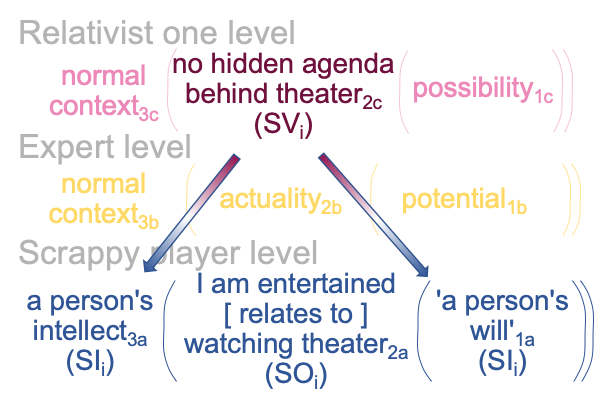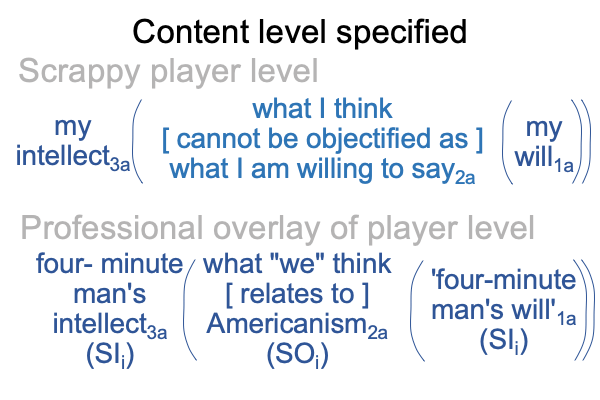0527 Creel and his associates support presentations of propaganda at locations where crowds gather and people are vulnerable.
The so-called “four-minute men” engage an audience in a film theater during the four-minutes that it takes to change a reel of film. These four-minute men testify to our patriotic duty and to our need to enter the European war. The presumption is that what the four-minute man is willing to say [objectifies] what the orator thinks. But, that is not honestly the case, since the four-minute presenter knows that he is a mouthpiece [that cannot truly objectify] the slogan that America can, and will, end war, itself.
0528 The venue for such presentations is cleverly chosen.
Practically, there can be no debate, since the films must go on. People come to see the films. So, only the time between reels is available for a testimonial.
Theoretically, each theater has no perspective other than the venue itself. Similarly, each battle among enlightenment gods has no perspective other than itself. Likewise, the relativist one3c represents no perspective other than itself.
0529 This loss of perspective parallels the slogan, popularized in the modern era, of “art for art’s sake”. Art has no perspective other than the venue itself. Consequently, official displays of artistic works defines what “art” is, not on the basis of some sort of criteria or aesthetic, but on the basis of a gallery or a museum acting as an interventional sign-object(SOi).
This is the way of the interventional sign-relation, if there is a content-level sign-object (an art gallery or museum) that can be witnessed, then there must be a perspective-level sign-vehicle (corresponding to “art” as a transcendental value) that cannot be witnessed. The interventional sign-vehicle must be inferred.
If SOi, then SVi.
This is not logic. This is the nature of the interventional sign-relation.
0530 Here is a difficulty.
Since the audiences of the four-minute men are at the film theater in order to entertained by moving pictures (which are obviously illusions), why would they take seriously anything said by an orator speaking between reels?
0531 One answer may be that the purely relational structure of the interventional sign-relation is built into the hominin mind. It may be an adaptation to hand-talk in the Lebenswelt that we evolved in. After all, hand-talk itself is a key adaptation to teams (at first) and communities (after the domestication of fire).
Why not imagine that everything that we subjectively witness is the hand-talk of a supra-subjective presence? Why not imagine that a supra-subjective presence2c (SVi) stands for whatever we think and talk about2a (SOi) in regards to a normal context3a and a potential1a that each hominin exhibits (when engaged in team and community collaborative activities) (SIi)?
Plus, since hand-talk does not facilitate explicit abstraction, why not imagine that the interventional sign-relation is built into what we evolved to be?
0532 Only after the first singularity, with the ability of purely symbolic speech-alone talk to label anything and everything,can we break down the interventional sign-interpretant (SIi) into a content-level normal context3a and potential1a. Plus, we can associate these two elements to intellect3a and will1a, respectively. Steve Fuller notes that “reason3a,1a” consists of both intellect and will.
0533 Even in our current Lebenswelt, we tune into the interventional sign-relation, even when we go to the film theater with our dates. As already mentioned, the theory behind theater is that there is no hidden agenda behind the theater. The theater denies any supra-subjective being2c that otherwise might be present. I mean, it’s not like church, where a supra-subjective presence2c is palpable.
No hidden agenda2c (SVi) stands for my entertainment while attending theater2a (SOi) in regards to reason3a,1a, defined as my intellect3a contextualizing my will1a (SIi).

0534 So, what happens when one of Creel’s four-minute men takes the stage while the staff changes reels?
The interventional sign-relation changes subtly, from passively processing images that do not pertain to me to actively processing talk that recalls that I belong to teams and communities.
0535 Yes, the four-minute audience feels the actualization of an interventional sign-relation, where a suprasubjective judgment to go to war2c (SVi) stands for the four-minute orator’s words2a (SOi) in regards to “our” reason3a,1a (SIi).
A technical word for this actualization is coined by French Marxist theorist, Louis Althusser (1918-1990 AD). The word is “interpellation”. Interpellation plays a role in A Primer on How Institutions Think (by Razie Mah, available at smashwords and other e-book venues).
0536 The four-minute man offers a way to fill in the terms for the content-level for the scrappy player level.
Many take the bait.

As soon as a member of the audience takes the bait, there is a catharsis. My agreement with the four-minute man [can be objectified by] what I say. “We” agree with the will1a of the four-minute man.
0537 So, my conclusion may sound a little bit theological.
This is not about truth. The orator’s announcement of the coming of the kingdom of Woodrow Wilson’s Committee on Public Information offers a way to fill in the empty elements on the scrappy player level with specific food for thought. We can enter the Great War. We can call it A War To End All Wars. Aspiration becomes inspiration. Inspiration leads to collective action.
